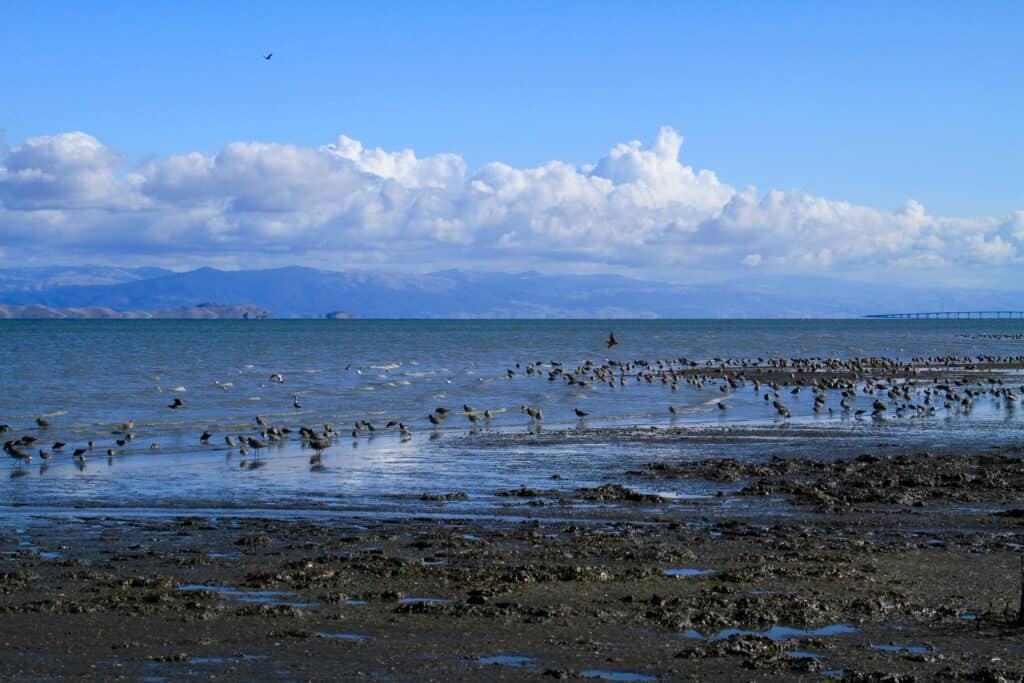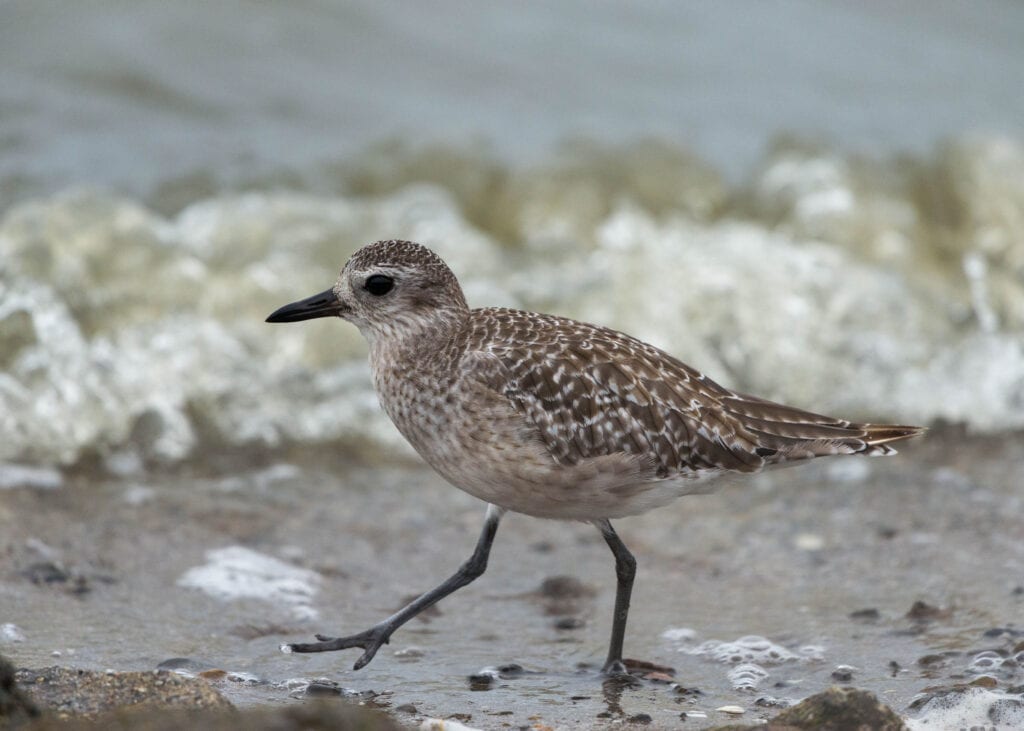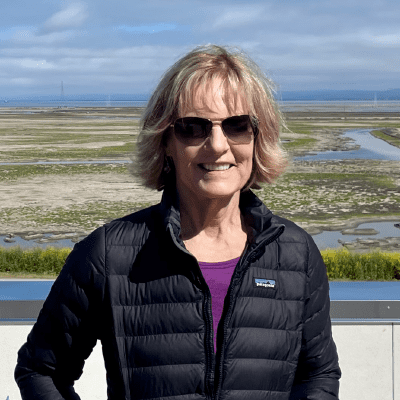As the largest estuary on the Pacific Coast, the San Francisco Bay is an incredibly resource-rich habitat for many different species of birds. While the Bay is a year-long home to many flying feathered creatures, it is also an important stopping point for migratory birds, specifically during fall and wintertime. The Pacific Coast is one of the most important stops for many bird species on their journey around the world. Every fall and winter, nature enthusiasts eagerly anticipate the many bird species that visit the Bay to eat, rest and breed. If you are interested in bird watching, or just curious about the winged creatures that are hanging out in your neighborhood this season, here’s a few migratory and year-long birds that are known to roam the San Francisco Bay area. If you are lucky, maybe you’ll be able to sneak a peek at one this winter! And no matter where you go to bird watch, don’t forget to bring your binoculars.
Shorebirds

If you have spent any time volunteering with Save The Bay’s team on the shoreline, you have probably seen shorebirds wading in the waters nearby or flying majestically overhead. Shorebirds are known for their migration skills – many shorebirds can fly around just about the entire world with only a few stops!1 To do this, they store tons of fat and muscle by eating invertebrates and worms to use on their migration journey. They also shrink some of their organs (yes, you read that right) and thicken their heart and blood to allow for optimal flying conditions.1 Shorebirds rest, eat, and breed on beaches, wetlands, and lake edges around the world, depending heavily on this specific environment for survival. Unfortunately, this means that the decline of these areas directly impacts bird populations. Coastal wetland habitats are highly threatened in the Bay and elsewhere by the impacts of climate change, making shorebirds one of the most at-risk groups of endangerment or even extinction.2 Save The Bay works daily to ensure the protection and restoration of wetlands for shorebirds and other species threatened by the impacts of climate change. See below for a few of the Bay’s best and brightest shorebird species!
Black-Bellied Plover

The Black-Bellied Plover (Pluvialis squatarola) is a shorebird that spends its winters in the Bay Area. We can recognize them for their grey feathers and white breast, their uniforms during the months when they are not breeding.3 Keeping up with its migration reputation, the Black-Bellied Plover can fly incredible distances without stopping. In fact, the Canadian Wildlife Service recorded a bird travelling all the way from Canada to Brazil without once stopping.3 You can find the Black-Bellied Plover running along beaches and mudflats in search of food in the winter until about April, when they will be off migrating to the Arctic. The Elsie Roemer Bird Sanctuary at Crown Memorial State Beach in Alameda is a common wintering spot for the species.4
Least Sandpiper

If you have seen Disney’s animated short “Piper” then you are familiar with the smallest shorebird in the world: the Least Sandpiper (Calidris minutilla). This adorable bird, with its light brown feathers and short bill, is also known as ‘peep’ due to its high-pitched chirp.5 The Least Sandpiper weighs about three quarters of an ounce and spends its time near the ocean tides on the beach, searching for food. The San Francisco Bay can expect these visitors in our estuary in the winter months, where they spend their time after travelling all the way from their Arctic breeding grounds. Like other shorebirds, the Least Sandpiper changes the shape of its organs and packs on large amounts of fat and muscle before its trip down to California.5 If you are interested in spotting a least sandpiper this winter, head over to the Don Edwards San Francisco Bay National Wildlife Refuge.6 This large coastal wetland area is habitat for thousands of animal species that live in and visit the Bay.
Give for a Resilient Future
Your contribution will support vital restoration efforts, climate advocacy, and community engagement programs. Make a lasting impact and further our mission to protect and restore San Francisco Bay.
Raptors

One type of bird that you may be familiar with due to its predatory nature and strong American symbolism is a raptor. Raptors are often referred to as “birds of prey” because of their innate ability to capture their food with their sharp talons. As predators, raptors play a key role in their habitats by “keeping their biological community in balance” through maintaining the population of animals lower on the food chain.7 They are also important markers of the health of an ecosystem, as they bioaccumulate pesticides and harmful chemicals that are consumed by the surrounding environment. Many species of raptors were listed as endangered in the 70s due to the consumption of the pesticide DDT, which led to the banning of the harmful chemical.8 Below are just a few raptors that you may sneak a peek at this winter in the San Francisco Bay Area.
Bald Eagle

Bald eagles (Haliaeetus leucocephalus) may be the easiest bird to identify for a beginner bird watcher. The raptor’s iconic bright yellow beak and white head with large brown wings is hard not to spot if you are lucky enough to come across one. This massive bird has a wingspan of around 6.5 feet and can grow to around 3 feet tall.9 Bald eagles are indigenous to North America, and throughout the year they migrate from the lower 48 states into Canada and Alaska.9 Many spend their winters in the coastal wetlands of the Bay where they breed and lay eggs from about January to July.9 Fun fact: Bald eagles mate for life, and bald eagle pairs will almost always return to their nesting area as permanent breeding territory.9 The best time to see this iconic bird is during winter, starting in December. For your best bet at spotting a bald eagle this winter, visit the Don Edwards San Francisco Bay National Wildlife Refuge.6 You can also look for bald eagles up in the Muir Beach Overlook or Point Reyes National Seashore, where you may see a bald eagle resting in the trees nearby.10 Head over to the Sweeney Ridge trail in the South Bay or Mount Diablo State Park in East Bay and hike up the mountains to spot a bald eagle or two hunting nearby.
American Kestrel

On the opposite side of the size spectrum is the American Kestrel (Falco sparverius), the tiniest North American falcon. Unlike other raptors, this bird may just be too adorable to fear. Coming in at 3-6 ounces with blue-gray or brown wings, the feathered creature is often mistaken for a mourning dove due to its size and coloring. Unlike the Mourning Dove, the Kestrel is known for its feisty nature and predatory instincts. This species can see in ultraviolet light, and uses this evolutionary superpower to catch its prey by spotting their urine trails.11 The American kestrel stays year round in the Bay Area, where it nests in the hollows of trees and hunts insects, birds, and small mammals.11 If you want to see this cute predator, head over to La Honda Creek Open Space Preserve in Redwood City with your binoculars and search for small crevices in trees and rocks where they may be perched.
Songbirds

Songbirds are an iconic type of bird known for their ability to create complex tunes that inspire and calm us in their presence. All songbirds are perching birds, meaning they have a specific type of toe arrangement that allows them to grab onto branches and stay upright even when they are asleep. But what gives songbirds their talented vocals? They possess specific muscles surrounding their syrinx organ that allows them to have unique vocal control.12 Songbirds are therefore able to sing dramatic ballads to attract a mate or defend their territory.12 What also makes songbirds unique is the way that they learn and produce music. Songbirds learn songs from listening to their parents instead of knowing them intuitively. Some songbirds just have one song, whereas others use their ability to learn music to collect an array of sounds throughout their lives. Sometimes female and male birds even duet with one another! Below are a few songbirds of the Bay Area that you may see (or hear) if you are lucky.
Varied Thrush

The Varied Thrush (Ixoreus naevius) is migratory, usually found in the Bay Area in the winter months. It is known for its large, round orange breast and black and grey striped wings. The Varied Thrush’s song is very iconic, described by artist Louis Agassiz Fuertes “perfectly the voice of the cool, dark peaceful solitude which the bird chooses for its home as could be imagined”.12 This bird loves to spend its time during the winter months in the forests of the Pacific Northwest, scrounging the floor for bugs, seeds, and berries. If you are looking to catch a Varied Thrush this winter and possibly hear its tune, head over to Golden Gate Park, where it may be hanging around the more forested areas. You can also plant native fruiting shrubs or ground seeders in your yard or community garden to attract the Varied Thrush to your area. But careful, they tend to be aggressive and may dominate other bird species!
To hear the song of the Varied Thrush, click here.
Golden-Crowned Sparrow

The Golden-Crowned Sparrow (Zonotrichia atricapilla) is a migratory bird that spends its winters in the Bay Area. As stated in its name, this bird is known for its brown feathers and a bright yellow-gold stripe on its forehead. The Golden-Crowned Sparrow has a particularly sad song, which gained it the nickname of ‘Weary Willie’. In fact, if you listen closely, it almost sounds like the bird is saying “I’m so tired”.13 During the Gold Rush in California, miners referred to the Golden-Crowned Sparrow as the ‘no gold here’ bird, due to its melancholy singing in the background of their failed ventures.12 Its habitat on the West Coast consists of weedy fields and shrublands, where it may be seen looking for insects while hopping around on the ground. If you want a view of the Golden-Crowned Sparrow this season, head over to the Presidio grasslands and coastal shrub areas, where you can catch a glimpse at this bird searching for food or maybe even singing a sad tune.
To hear the song of the Golden-Crowned Sparrow, click here.
Sources
- 5 Reasons Why Shorebirds Are Awesome
- Shorebirds, The World’s Greatest Travelers, Face Extinction
- Species Profile: Black-bellied Plover
- Robert W. Crown Memorial State Beach
- Meet The Smallest Sandpipers of the San Francisco Bay
- Don Edwards San Francisco Bay National Wildlife Refuge
- What Are Raptors?
- Bald Eagles in California
- Bald Eagle
- 6 Great Places To See Bald Eagles In The San Francisco Bay Area
- American Kestrel
- What Is a Songbird, Exactly?
- Golden-crowned Sparrow

















































